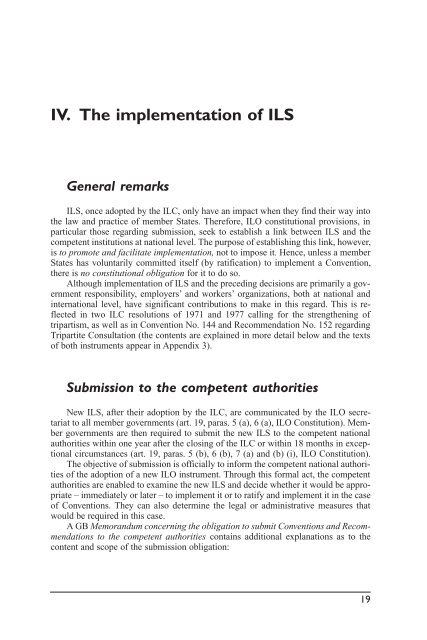Employers' Handbook on ILO Standards-related Activities
Employers' Handbook on ILO Standards-related Activities
Employers' Handbook on ILO Standards-related Activities
Create successful ePaper yourself
Turn your PDF publications into a flip-book with our unique Google optimized e-Paper software.
IV. The implementati<strong>on</strong> of ILS<br />
General remarks<br />
ILS, <strong>on</strong>ce adopted by the ILC, <strong>on</strong>ly have an impact when they find their way into<br />
the law and practice of member States. Therefore, <strong>ILO</strong> c<strong>on</strong>stituti<strong>on</strong>al provisi<strong>on</strong>s, in<br />
particular those regarding submissi<strong>on</strong>, seek to establish a link between ILS and the<br />
competent instituti<strong>on</strong>s at nati<strong>on</strong>al level. The purpose of establishing this link, however,<br />
is to promote and facilitate implementati<strong>on</strong>, not to impose it. Hence, unless a member<br />
States has voluntarily committed itself (by ratificati<strong>on</strong>) to implement a C<strong>on</strong>venti<strong>on</strong>,<br />
there is no c<strong>on</strong>stituti<strong>on</strong>al obligati<strong>on</strong> for it to do so.<br />
Although implementati<strong>on</strong> of ILS and the preceding decisi<strong>on</strong>s are primarily a government<br />
resp<strong>on</strong>sibility, employers’ and workers’ organizati<strong>on</strong>s, both at nati<strong>on</strong>al and<br />
internati<strong>on</strong>al level, have significant c<strong>on</strong>tributi<strong>on</strong>s to make in this regard. This is reflected<br />
in two ILC resoluti<strong>on</strong>s of 1971 and 1977 calling for the strengthening of<br />
tripartism, as well as in C<strong>on</strong>venti<strong>on</strong> No. 144 and Recommendati<strong>on</strong> No. 152 regarding<br />
Tripartite C<strong>on</strong>sultati<strong>on</strong> (the c<strong>on</strong>tents are explained in more detail below and the texts<br />
of both instruments appear in Appendix 3).<br />
Submissi<strong>on</strong> to the competent authorities<br />
New ILS, after their adopti<strong>on</strong> by the ILC, are communicated by the <strong>ILO</strong> secretariat<br />
to all member governments (art. 19, paras. 5 (a), 6 (a), <strong>ILO</strong> C<strong>on</strong>stituti<strong>on</strong>). Member<br />
governments are then required to submit the new ILS to the competent nati<strong>on</strong>al<br />
authorities within <strong>on</strong>e year after the closing of the ILC or within 18 m<strong>on</strong>ths in excepti<strong>on</strong>al<br />
circumstances (art. 19, paras. 5 (b), 6 (b), 7 (a) and (b) (i), <strong>ILO</strong> C<strong>on</strong>stituti<strong>on</strong>).<br />
The objective of submissi<strong>on</strong> is officially to inform the competent nati<strong>on</strong>al authorities<br />
of the adopti<strong>on</strong> of a new <strong>ILO</strong> instrument. Through this formal act, the competent<br />
authorities are enabled to examine the new ILS and decide whether it would be appropriate<br />
– immediately or later – to implement it or to ratify and implement it in the case<br />
of C<strong>on</strong>venti<strong>on</strong>s. They can also determine the legal or administrative measures that<br />
would be required in this case.<br />
A GB Memorandum c<strong>on</strong>cerning the obligati<strong>on</strong> to submit C<strong>on</strong>venti<strong>on</strong>s and Recommendati<strong>on</strong>s<br />
to the competent authorities c<strong>on</strong>tains additi<strong>on</strong>al explanati<strong>on</strong>s as to the<br />
c<strong>on</strong>tent and scope of the submissi<strong>on</strong> obligati<strong>on</strong>:<br />
19

















